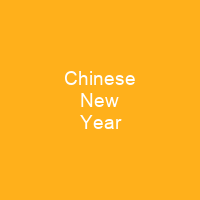Chinese New Year: A Time of Celebration and Tradition
Imagine a festival that has been celebrated for thousands of years, marking the beginning of spring and the end of winter. That’s Chinese New Year! It’s not just any holiday; it’s a vibrant celebration filled with rich traditions, colorful decorations, and delicious foods. Have you ever wondered how this ancient tradition has managed to survive through centuries?
The Origins of Chinese New Year
Chinese New Year, also known as the Spring Festival or Lunar New Year, is a festival that dates back over 4,000 years. The story goes that during the Han dynasty (202 BC-220 AD), a monster named Nian would attack villages on the eve of the new year. One day, an old man came to save the village and taught them to honor deities, use red colors, and make loud noises with firecrackers. Isn’t it fascinating how such a simple story has shaped one of the world’s most significant celebrations?
The Evolution of Chinese New Year Traditions
Over time, these traditions evolved into what we see today. During the Tang dynasty (618-907 AD), sending bai nian tie, or New Year’s greeting cards, became a popular custom. The tradition spread and later became a general practice among people who used Xuan paper instead of gold leaves. Another theory suggests that bai nian tie was derived from the Han dynasty’s name tag, men zhuang. These small pieces of history tell us so much about the evolution of Chinese culture.
The Significance of Red
Red is a predominant color in Chinese New Year celebrations for several reasons. It symbolizes joy, virtue, truth, and sincerity. In ancient times, red was used to ward off evil spirits, and even today, it’s worn as a symbol of good luck. Isn’t it amazing how such a simple color can carry so much meaning?
The Global Celebration
Chinese New Year is celebrated not just in China but also in many countries around the world. In Southeast Asia, it’s a national public holiday in many countries and considered one of the most important holidays of the year. In Malaysia, George Town celebrates for 15 days, while in Singapore, it’s a two-day public holiday with festive activities like the Chinatown celebrations and Chingay Parade. In the Philippines, Chinese New Year is an important festival for its Chinese population, with celebrations centered in Manila’s Binondo Chinatown. These celebrations show how deeply ingrained this tradition has become globally.
The Lantern Festival
The Lantern Festival, which marks the end of the Chinese New Year celebration, is a magical event where people light lanterns and release them into the sky. It’s a symbol of hope and new beginnings. Imagine walking through a sea of glowing lanterns; it’s like stepping into a fairy tale.
The Reunion Dinner
No Chinese New Year celebration is complete without the reunion dinner on New Year’s Eve. This meal brings families together to share stories, enjoy delicious food, and exchange red packets. These red envelopes contain money as a symbol of good luck and fortune for the coming year. It’s not just about the food; it’s about the love and connection shared among family members.
The Future of Chinese New Year Celebrations
As technology advances, so do the ways in which we celebrate. In modern times, red packets are given by married couples to younger family members, particularly children, and are kept under the pillow for seven nights after Chinese New Year before being opened to symbolize good luck and fortune. The tradition has evolved but remains as meaningful as ever.
Conclusion
Chinese New Year is more than just a holiday; it’s a celebration of life, family, and hope. From the ancient stories of Nian to the vibrant traditions of today, this festival continues to bring people together in joy and unity. As we look forward to future celebrations, let us embrace these rich traditions and carry them forward into the new year.

You want to know more about Chinese New Year?
This page is based on the article Chinese New Year published in Wikipedia (retrieved on December 19, 2024) and was automatically summarized using artificial intelligence.





